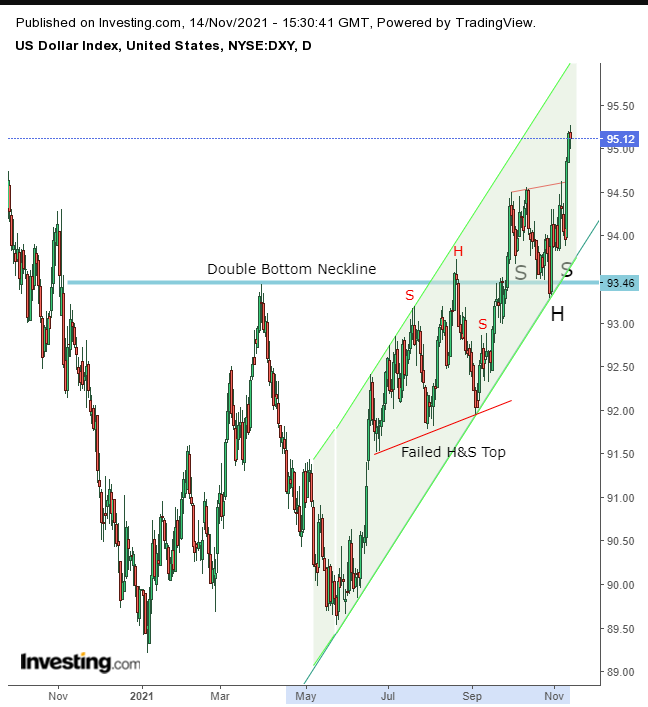Consumer spending expanded by a mere 1.6% for the last quarter, a severe fall-off from the 12% growth in the second quarter. Since consumer spending makes up 69% of the $23.2 trillion US economy, this drop is critical.
At the same time, US CPI surged, up 6.2% year-over-year, the highest for this metric in 30 years. Spiking inflation has created a scenario in which the Fed may have to tighten policy more quickly than it wished to. As such, traders have begun pricing in a stronger US dollar.
Does that mean the greenback is now fully priced? Not according to the principles of supply and demand.

The USD completed a small H&S continuation pattern, signalling a resumption of the underlying uptrend, framed within the rising channel.
The H&S is a natural consequence of the preceding failed H&S top. When the would-be bearish pattern blew out, it forced traders to reverse positions, creating the impetus for the bullish H&S we first discussed.
Note how the successful H&S and failed H&S developed on opposing sides of the neckline of a massive double bottom since November of last year.
This chart is a vivid example of how the forces of supply and demand come together in a chaotic yet elegant tapestry of the financial market.
Trading Strategies
Conservative traders should wait for the price to execute a return move to retest the neckline of the H&S continuation pattern, which may coincide with the bottom of the rising channel.
Moderate traders would wait for the same pullback, but for a better entry, not necessarily to confirm the bullish trend.
Aggressive traders could enter a long position at will, provided they accept the risk of a whipsaw before the price resumes along its trajectory. A coherent trade plan is essential. Here's an example:
Trade Sample–Aggressive Long Position
- Entry: 95:00
- Stop-Loss: 94.50
- Risk: 50 pips
- Target: 97:00
- Reward: 200 pips
- Risk:Reward Ratio: 1:4
Author's Note: This is a trade "sample," not a prophecy. We do not pretend to know the future. We are simply interpreting our understanding of the supply-demand forces according to the principles of technical analysis. The idea is to customize a trading plan according to your personal goals that reflect your budget, temperament and timing so that you can hope to work using positive statistical results. Winning or losing this one trade is not statistically representative. So, don't praise it if it wins, or lose faith if it fails. The purpose of this post is to help readers gain understanding in order to set up your own trades, not blindly follow someone else's. Happy Trading!
